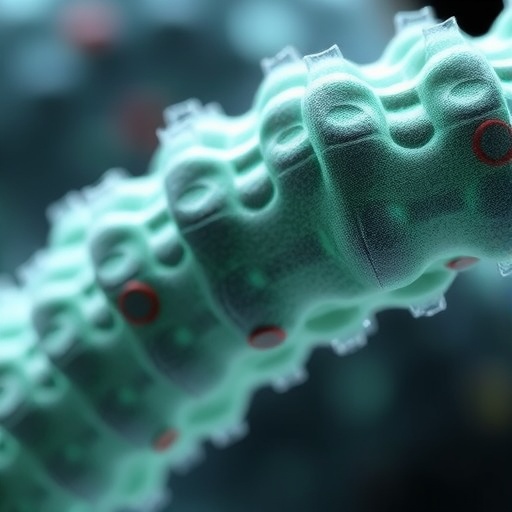
In a groundbreaking discovery that challenges long-held assumptions in the origins of life research, scientists at Ludwig-Maximilians-Universität München (LMU) have unveiled a plausible mechanism allowing metabolic-like processes to occur without the presence of cell membranes. This novel insight may fundamentally reshape our understanding of how the earliest forms of life could have operated in the primordial Earth environment, offering a fresh perspective on the classic chicken-and-egg puzzle of life’s emergence: whether metabolism preceded the formation of cell membranes or vice versa.
The enigma that has puzzled biologists for decades centers on the intimate relationship between metabolism and cell membranes. Modern life is characterized by complex cellular entities enclosed by membranes that maintain distinct internal environments where diverse biochemical reactions take place in a highly controlled manner. Yet, no known organism thrives without a membrane encapsulating its metabolic machinery. This interdependence raises a particularly vexing question: how could metabolism develop in the absence of membranes, and how could membranes form without preexisting metabolism?
Addressing this conundrum, the LMU research team led by Professor Dieter Braun published a seminal study, appearing in Nature Physics, that demonstrates how a simple physical phenomenon—thermal gradients across micron-scale, water-filled pores—can facilitate the accumulation and concentration of a variety of molecular species. This environment enables molecular interactions and reaction sequences typically thought to require membrane-bound compartments. Intriguingly, these confined, membraneless ‘protocells’ replicate some of the essential functions normally attributed to cell membranes by harnessing heat flow as a driving force.
.adsslot_0LYGcmpQ17{ width:728px !important; height:90px !important; }
@media (max-width:1199px) { .adsslot_0LYGcmpQ17{ width:468px !important; height:60px !important; } }
@media (max-width:767px) { .adsslot_0LYGcmpQ17{ width:320px !important; height:50px !important; } }
ADVERTISEMENT
The experiments simulate scenarios that closely resemble conditions found on the early Earth’s rocky surfaces. Specifically, they focus on water-saturated mineral pores subjected to stable thermal gradients: one side heated and the other cooled, creating a gradient that promotes convection and thermophoresis—the movement of molecules driven by temperature differences. Rather than diffusing evenly, molecules with disparate physical and chemical properties accumulate preferentially towards the colder region of these pores, thereby localizing reactants and catalyzing interactions in a manner reminiscent of biochemical compartmentalization.
To explore the implications of this physical confinement, the LMU team constructed bespoke microfluidic chambers mimicking thin water layers constrained between transparent plates. These ‘thermal chambers’ allow precise control and observation of molecular behavior under imposed temperature gradients. Within this setup, the researchers introduced a complex mixture of over a hundred components mimicking a simplified prebiotic soup, including amino acids, nucleotides, ribosomes, polymerases, and other biomolecular machinery essential for protein synthesis.
One of the standout achievements of this work is the successful synthesis of superfolder green fluorescent protein (sfGFP)—a robust, fluorescent reporter protein—demonstrating that even significantly diluted molecular mixtures can be concentrated and activated within the thermal gradient environment to drive biologically relevant reactions. Without the thermal convection present, such reactions stall due to insufficient molecular concentration, highlighting the critical role of the thermal gradient in overcoming dilution limits intrinsic to simple aqueous solutions.
This approach effectively sidesteps the necessity of traditional lipid-based membrane compartments. Instead, the physical gradient acts as an organizing principle, concentrating reaction components in a confined space while still allowing molecular diffusion and interaction. This nuanced mechanism suggests that primordial metabolic networks could have evolved within these membraneless protocells long before the emergence of true cellular membranes.
Beyond its profound implications for the origin-of-life field, the study births exciting prospects for synthetic biology and biotechnology. The capacity to mimic cell-like functions without relying on complex membrane structures could revolutionize efforts to engineer artificial cells or minimal living systems. Conventional synthetic cells commonly require membrane synthesis and maintenance, a formidable engineering hurdle. The LMU results imply that thermal gradient–driven confinement might serve as a modular platform to develop self-sustaining synthetic biochemical circuits capable of growth and division, circumventing membrane dependency.
Alexander Floroni, the paper’s lead author, emphasizes that while laboratory recreations of these thermal environments face constraints—such as chamber size and achievable temperature differentials—early Earth’s geological diversity would have provided a plethora of natural microenvironments, including pores of varying shapes and sizes with vast temperature ranges. These natural settings could have served as cradles for life’s initial metabolic steps, facilitating the transition from chemical to biological systems.
The mechanism elucidated here also offers a plausible answer to one of the fundamental questions of astrobiology: could life arise independently in environments devoid of conventional cellular structures? The presence of membraneless protocells driven by physical gradients might broaden the scope of habitable environments beyond Earth, hinting at possible biosignatures to search for on other planetary bodies featuring porous rock and liquid water.
From a theoretical standpoint, this discovery complements ongoing efforts to decode the minimal requirements for life. It suggests that life’s hallmark features—autocatalysis, compartmentalization, and metabolism—may emerge from simple physico-chemical principles without demanding complex biochemistry initially. The distinction between life and non-life becomes increasingly blurred under these findings, providing a new lens to view the early stages of evolution.
Moreover, this research echoes and extends classical hypotheses regarding the role of hydrothermal vents and porous rocks in prebiotic chemistry. By demonstrating actual experimentally validated examples of biochemical activity facilitated solely by thermal gradients in membraneless environments, LMU’s work bridges a vital gap between theory and empirical observation.
In sum, this pioneering study spearheaded by Professor Dieter Braun and colleagues sketches a compelling narrative that life’s early metabolic functions could have been reliably catalyzed in membraneless, thermally confined microenvironments. Their work not only enhances our comprehension of life’s origins but also paves the way for innovative biotechnological applications, potentially heralding a new era in synthetic cell construction.
As we contemplate the broader implications, it becomes apparent that harnessing environmental physics such as heat flow could become a cornerstone in realizing artificial living systems, overcoming hurdles that have long stalled advances in bottom-up synthetic biology. Nature may have cleverly exploited thermodynamic gradients long before membranes emerged as cellular boundary markers—thus, life’s subtle dance between order and chaos may have begun in the warmth of tiny rock pores.
Subject of Research: Origin of Life / Membraneless Protocells / Prebiotic Metabolism
Article Title: Membraneless protocell confined by a heat flow.
News Publication Date: 26-Jun-2025
Web References: https://doi.org/10.1038/s41567-025-02935-4
References: Braun, D. et al. Membraneless protocell confined by a heat flow. Nature Physics (2025).
Keywords: Origin of life, protocells, membraneless compartments, thermal gradients, prebiotic chemistry, synthetic biology, metabolism, thermal convection, microfluidics, green fluorescent protein, biochemistry, early Earth
Tags: biochemical reactions in early lifecell membrane formation theorieschicken-and-egg puzzle of lifeevolution of early cellular lifefundamental biology discoveriesinterdependence of metabolism and membraneslife’s emergence mechanismsLudwig-Maximilians-Universität München researchmembranes and metabolism originsmetabolic processes without membranesprimordial Earth life processesthermal gradients in biochemical reactions



